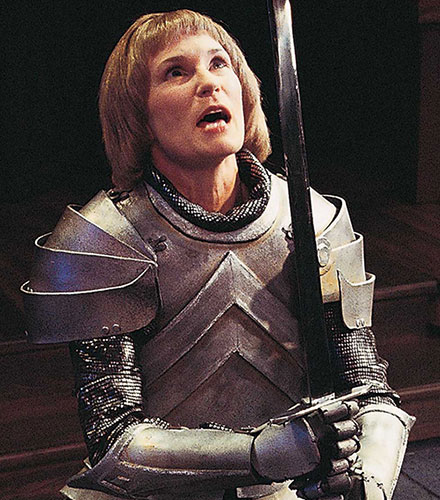The History Cycle Continues

Kathleen McCall as Joan la Pucelle in The War of the Roses, 2000.
It sounds like the characters of a sweeping English soap opera: King John who signed the Magna Carta in 1215, then died of dysentery a year later. Richard II, a weak king whose throne was taken from him by his cousin. Henry IV whose right to the throne was always suspect. Prince Hal, who rose from his riotous youth to become the beloved but short-lived Henry V. His son, who became King Henry VI while an infant and suffered from debilitating mental illness his entire life. The murderous hunchback, Richard III. And, finally, King Henry VIII, the father of Queen Elizabeth, who ruled during much of Shakespeare’s life.
Shakespeare traces the lives of these seven kings (and a few others) through his ten history plays. Although the plays aren’t strictly historical, they do make a fascinating chronical, compared by many to the popular television series Game of Thrones, with power struggles and political infighting reflective of our world today. And that is part of the reason the Utah Shakespeare Festival has chosen to produce these ten plays in chronological order: their resonance with today’s headlines.
The Festival started the initiative in 2013 by producing King John in the summer and Richard II in the fall, then continued through Henry IV Part One in 2014, and Henry IV Part Two in 2015, reaching the halfway point with Henry V in 2016.
In 2018, the Festival begins the second half of the History Cycle with Henry VI Part One, a seldom-produced play with a huge cast of characters (including Joan of Arc) and which chronicles the beginning of the end of the Hundred Years War between England and France and sets the stage for the start of the bloody English civil war, the Wars of the Roses.
“Performing the history plays in chronological order gives a clarity to the arc of the story,” said Artistic Director Brian Vaughn. “They tell a time of complicated English history, of a line of kings and the transference of power. Performing them in order helps you connect the dots a little easier, and makes the action more applicable to today’s world.”
Vaughn also noted that the ten plays all stand up well on their own, but that they are even better together as part of this immerse story which spans over 300 years and ends with the baptism of the baby Elizabeth who will eventually reign as queen over a peaceful and prosperous England for forty-five years, including most of Shakespeare’s life.
“These are plays about people and families,” he said. “They are giant soap operas, English soap operas that tell the story of intrigue, infighting, love, and hate between these families, all of them related.”
“It is soap opera in verse,” added Executive Producer Frank Mack. “The history can be complicated, but the story is ultimately fascinating and personal.”
Vaughn is proud of the work presented on the Festival stages for the first half of the cycle. He is also aware that the next three plays, the three parts of Henry VI, will be a challenge. The plays are seldom produced separately. Instead the three are usually combined into one or two, making it easier to tell the complicated story of the Wars of the Roses. “We are going to do all three,” he said. “We don’t know many details yet, but our plan is to follow Henry VI Part One in 2018 with Henry VI Part Two and Henry VI Part Three sometime after that.”
Henry VI Part One begins at the funeral of Henry V. The heir to the throne is an infant, and the world is changing. The Hundred Years War with the French begins to wind down by the end of the play, but the houses of Lancaster and York in England are beginning to scheme and argue over the throne, paving the way for several decades of vicious civil war which would become known as the Wars of the Roses.
“During the Wars of the Roses, the idea of chivalry begins to decay,” said Vaughn. “War becomes more aggressive, as chivalry becomes less important.” Joan of Arc becomes a symbol of this new warfare. She is vicious and deceptive, all the while claiming to be led by heavenly visions.
The second half of the History Cycle, the wild ride of British royal history and soap opera, will begin on June 29, 2018 with a preview performance of Henry VI Part One. The Wooden O of the Engelstad Shakespeare Theatre will once again be filled with the sights and sounds of humanity and life.
Tickets are now on sale for the Festival’s 57th season, which will run from June 28 to October 20. Besides Henry VI Part One, this year’s plays are The Merchant of Venice, The Merry Wives of Windsor, Othello, Big River, The Foreigner, The Liar, and Pearl’s in the House. For more information and tickets visit www.bard.org or call 1-800-PLAYTIX.
The Utah Shakespeare Festival is part of the Beverley Taylor Sorenson Center for the Arts at Southern Utah University, which also includes the Southern Utah Museum of Art (SUMA).









